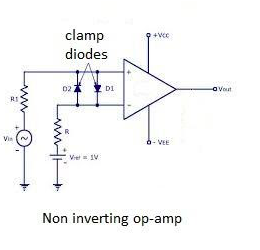
What are the diodes(D1 &D2) used in a comparator circuit ?
A) Clip diodes
B) Clamp diodes
C) PIN diodes
D) Fast recovery diode
Answer
471.6k+ views
Hint:For finding the type of diodes, we will define the comparator circuit first and its working.
Then we will find the function which diodes perform in the comparator circuit, after that we can easily make out the diodes used in the comparator circuit.
Complete step by step solution:
Comparator circuit: The comparator is an electronic decision making circuit that makes use of an operational amplifier having very high gain in its open-loop state, that is there will be no feedback resistor.
The comparator compares a signal voltage on one input of an op amp with a known reference voltage on the other input. Comparator usually has two inputs, one is constant reference voltage and the other is a time varying voltage signal .
When the non inverting input is larger than the inverting voltage the comparator produces a high output voltage +Saturation. When the non-inverting input is less than the inverting input the output voltage will –Vsaturation .

The above circuit diagram shows the diodes D1 and D2 .These two diodes are used to protect the op-amp from damage due to increase in input voltage. These diodes are called clamp diodes because they clamp the differential input voltage to either 0.7V or -0.7V .
Thus option 2 is correct.
Note:Most useful application of a comparator circuit is a humidity monitoring system of soil based on wireless sensor networks. The system is designed for developing an automatic irrigation system that can control the switching operation of the pump motor depending upon the moisture content in the soil.
Then we will find the function which diodes perform in the comparator circuit, after that we can easily make out the diodes used in the comparator circuit.
Complete step by step solution:
Comparator circuit: The comparator is an electronic decision making circuit that makes use of an operational amplifier having very high gain in its open-loop state, that is there will be no feedback resistor.
The comparator compares a signal voltage on one input of an op amp with a known reference voltage on the other input. Comparator usually has two inputs, one is constant reference voltage and the other is a time varying voltage signal .
When the non inverting input is larger than the inverting voltage the comparator produces a high output voltage +Saturation. When the non-inverting input is less than the inverting input the output voltage will –Vsaturation .

The above circuit diagram shows the diodes D1 and D2 .These two diodes are used to protect the op-amp from damage due to increase in input voltage. These diodes are called clamp diodes because they clamp the differential input voltage to either 0.7V or -0.7V .
Thus option 2 is correct.
Note:Most useful application of a comparator circuit is a humidity monitoring system of soil based on wireless sensor networks. The system is designed for developing an automatic irrigation system that can control the switching operation of the pump motor depending upon the moisture content in the soil.
Recently Updated Pages
Master Class 12 Economics: Engaging Questions & Answers for Success

Master Class 12 Maths: Engaging Questions & Answers for Success

Master Class 12 Biology: Engaging Questions & Answers for Success

Master Class 12 Physics: Engaging Questions & Answers for Success

Master Class 12 Business Studies: Engaging Questions & Answers for Success

Master Class 12 English: Engaging Questions & Answers for Success

Trending doubts
Which are the Top 10 Largest Countries of the World?

Differentiate between homogeneous and heterogeneous class 12 chemistry CBSE

Draw a labelled sketch of the human eye class 12 physics CBSE

What is the Full Form of PVC, PET, HDPE, LDPE, PP and PS ?

What is a transformer Explain the principle construction class 12 physics CBSE

What are the major means of transport Explain each class 12 social science CBSE




